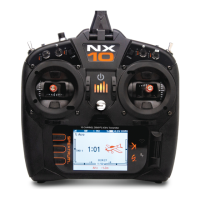45SPEKTRUM NX10 • TRANSMITTER INSTRUCTION MANUAL
EN
Aileron to Rudder
The Aileron to Rudder mix is commonly used for coordinated turns.
When active, as aileron is applied the rudder moves in the same
direction as the turn (right aileron input results in right rudder
output). If you assign the flight mode to a switch, a Sub Switch
option allows you to assign an additional switch to activate up to 3
Aileron to Rudder mixes for that flight mode.
Aileron to Flap
The Aileron to Flap mix allows the entire trailing edge of the wing
(aileron and flap) to operate as ailerons. When active, as aileron is
applied the flaps also move. Always program the flaps to move in
the same direction as the turn (so that right aileron is equivalent to
flaps moving as right ailerons).
Elevator to Flap
Elevator to Flap mix creates additional lift, allowing a tighter turn.
The entire trailing edge of the wing (aileron and flap) operates
as flaps (camber increase) when you apply elevator. An offset is
provided, which is typically used for Snap Flaps. With Snap Flap,
no Elevator to Flap mix occurs until the offset value is reached.
Typically, this offset is at 70% up elevator so that beyond 70%
the down flap mix comes in, providing additional lift for more
aggressive turning (for tight thermals or racing turns).
Flap to Elevator
Flap to Elevator mix prevents pitch up tendency that occurs when
you apply Crow or Butterfly. This mix is typically used only with the
Camber System. The Flap to Elevator mix operates as a curve so
that the elevator moves down the most during the first 20% of flap
deployment, decreases over the next 40%, then remains the same
from 60 to 100% of flap travel.
For sailplanes with ailerons/tips/flaps, make sure an appropriate
Sailplane Type is selected so that tips appear in the transmitter as
RAIL and LAIL. Decrease or increase travel on the tip ailerons by
creating an AIL > RAIL mix.
For each of these mixes, you can program each flight mode with
different mix values or at 0% if no mix is desired for that specific
flight mode. Programming values include independent control of
the direction and amount a slave surface moves in relationship to
the master surface.
The V-Tail Differential screen enables you to increase or decrease
the amount of differential between control surface throws.
Positive Differential values decrease the amount of “down” travel
without affecting the “up” travel on the opposite control surface.
Negative Differential values decrease the amount of “up” travel
without affecting the amount of “down” travel on the opposite
control surface.
The V-Tail Differential menu option only appears when V-Tail A or
V-Tail B is active in Aircraft Type.
To adjust the V-Tail Differential:
1. Scroll to Switch and press the scroll wheel. Scroll right to
select On (Differential is always on) or assign the differential to
a switch position.
2. Press the scroll wheel a second time to save the selection.
3. Scroll to Diff: and press the scroll wheel once to change the
value.
4. Press the scroll wheel again to save the selection.
SAIL Mixing
V-Tail Differential

